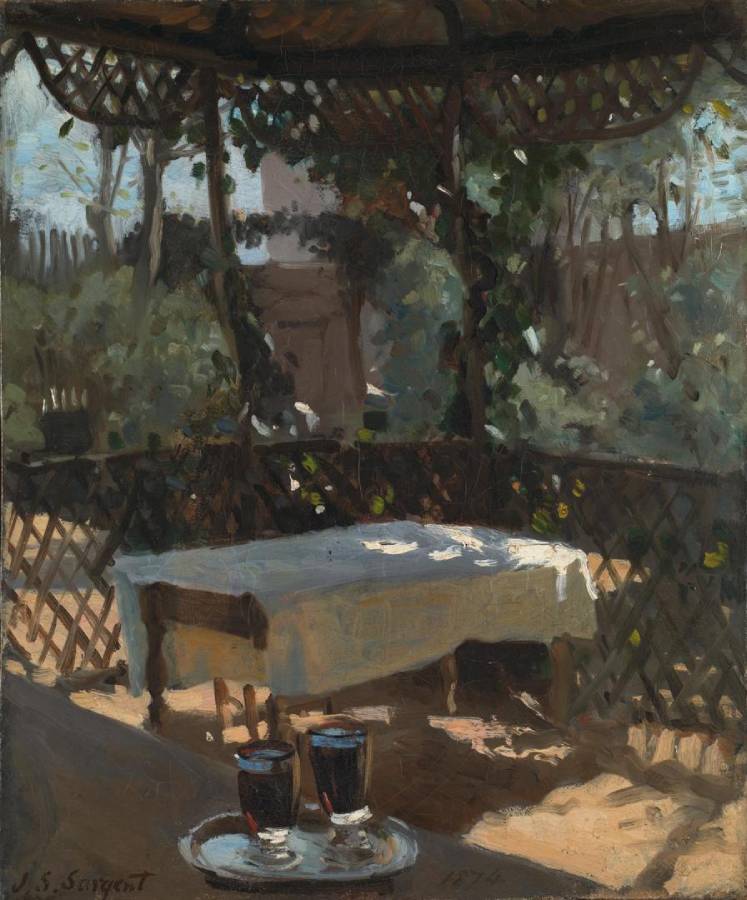Sargent, John Singer (1856-1925)
Wineglasses
probably 1875
Oil on canvas, 45 × 37.5 cm
National Gallery, London
This small painting of a shaded arbour could be set in a cafe or restaurant, but it may be a private garden. Dappled sunlight falls through the trellis and dark foliage to illuminate the sandy floor and a table covered by a white cloth. Although no people are present, two filled wine glasses on a silver tray – the objects closest to us – suggest a meeting, or perhaps a romantic assignation.
Sargent is particularly attentive to the play of light and the way that objects, such as the tablecloth, reflect light and colours from their surroundings. He uses a loose flickering brushstroke, without reworking or blending the paint, to create an effect of immediacy and freshness. Areas directly lit by the sun are painted using a fluid impasto. This technique of painting alla prima (directly onto the canvas with a loaded brush) shows the influence of Impressionism, a new way of painting, particularly outdoors, which Sargent had been studying while in Paris. Here he combines Monet’s interest in optical atmospheric effects with Pissarro’s darker tones and sense of structure. This type of setting – an outdoor location where there is eating and drinking – often appears in Impressionist paintings.
Despite its apparent informality, this is a highly structured, even complex, composition. Sargent is interested in the different shapes within the scene and in the visual relationship between surfaces and edges. Using the corners of the fence and the roof and also the strong diagonal of the sideboard, he creates a box-like space. He reinforces this by tightly cropping the picture space and by abruptly jumping from the detailed still life in the foreground to the out-of-focus foliage beyond. The box structure is reinforced by repeated right angles elsewhere in the picture – like the garden wall and the shape of the table. Other shapes are repeated elsewhere: the circular rims and bases of the wineglasses are echoed by the tray, the diamond pattern of the trellis is echoed by the large diamond patch of sunlit floor in the lower right corner and the verticals of the posts and tree trunks are repeated by the table legs. There may in fact be two tables, as the legs at either end do not match.
Sargent gave the painting to his teacher at time, Emile Carolus-Duran, with whom he had studied for three years while also being enrolled at the École des Beaux-Arts in Paris. Carolus-Duran, a fashionable portrait painter but also a friend of Courbet and Manet, was a proponent of realism, derived from Velázquez, based upon the direct observation of light and atmospheric effects. This picture is perhaps a demonstration piece in which Sargent, still only around 19 years old, displayed his precocious skill, particularly his control of contrasting light and dark tones.
Although retrospectively dated 1874 on the canvas, the picture was probably painted the following year either at Saint-Enogat in Brittany, where Sargent spent the summer of 1875, or in the picturesque village of Grez-sur-Loing in the forest of Fontainebleau. This had been a favourite haunt of the Barbizon artists and was also popular with Carolus-Duran’s students. (NG)
